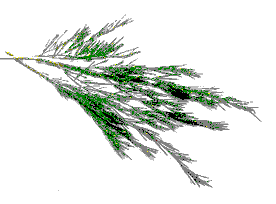South Africa: rainbows and deserts
History of Rooibos tea
The plant, area of production, cultivation and processing.
The plant - "Aspalathus Linearis"
The Aspalathus plant group, which falls under the legume family, and to which Rooibos tea belongs, consists of more than 200 species which occur only in South Africa and of which only the specie Aspalathus Linearis has any economic value. Had it not been for the mountain inhabitants in the Western Cape, this specie would today have been known merely as an ordinary shrublike bush of the mountains.
 ...the "Aspalathus
Linearis" plant
...the "Aspalathus
Linearis" plant
The Rooibos tea group, in turn, consists of different types, viz the Red tea, Black tea, Red-brown tea and the broadleaf Cedarberg types; all of which are closely related and differ only in respect of slightly deviating styles of growth, area of occurrence and quality of the processed product.
The Red tea type was the most sought after and it was this particular type in which Dr Nortier was interested and to which he applied his selections. The sub-genus is appropriately named after him, viz Nortieria. Since today only cultivated tea is produced, all marketed tea is derived from this selected Rooibos tea type and quite logically the old product name of Red tea had to make way for its increasingly popular descendant, viz Rooibos tea - a name which assures the consumer of high quality cultivated and processed product and which, in so doing, distances itself from its past, when its predecessor was known as a mixture of all the different types mixed together in different ratios - not to mention all the proper names linked to these types in earlier years. These were Koopmans tea, Needle tea or Pin tea, still collectively known to earlier generations as Bush-tea.
Botanically speaking, therefore, the Red tea era had to make way for a new era in the product's history, viz that of Rooibos tea.
The plant is a shrublike bush with a central smooth bark main stem which, near the soil surface, is already subdivided into various equally strong off-shoots followed by thin, flimsy side branches bearing the thin, sharp, soft, needlelike leaves of approximately 10 millimetres in length, singly or in bunches. The growth height varies from one to 1,5 metre in its natural state while the height of harvested plants varies from 0,5 to 1,5 metre depending on the age or the climate and soil conditions in the area of production.
Although the plant requires a production area with winter rainfall, its active growth only starts in spring, increasing towards midsummer after which growth declines, growing much less actively by the beginning of the cold months in autumn. Depending on the normal harvesting times which have a major affect on the growth pattern of the plant, the plant is usually covered with small, yellow, pea-shaped flowers during October, which in turn each produces a small legume containing only one, very small, light yellow, hard shelled, dicotyledonous seed.
This fairly drought resistant plant, however, seeks deeply for its moisture requirements with the aid of a tap-root, up to a depth of two metre below the surface depending on the soil depth, with a finely branched network of roots just below the ground surface. These roots grow very actively from the beginning of spring and we find attached to them the knobs of nitrogen fixing bacteria, which is typical of a legume.
Area of Production
As mentioned earlier, Rooibos tea is today produced on intensive scale in the mountains of the Western Cape but particularly in the districts Piketberg, Clanwilliam, Van Rhynsdorp and Calvinia. On either side of the Olifants River we find two mountain ranges running parallel to the river, viz the Olifants River mountain range to the east. In the former range we find the most southerly point of production in the Winterhoek Mountains directly opposite Porterville in the district Piketberg, while it stretches northwards up to the mountain peak, Langbergpunt, approximately 20 kilometre north-west of Clanwilliam.
In the Cedarberg mountain range it starts in the Buffelshoek Mountains on the southern border of the Ceres district approximately 40 kilometre sout-east of Citrusdal, stretching nortwards along the Cedarberg, Pakhuis, Nardouw, Gif and Maskam Mountains. The latter two mountain complexes are in the immediate vicinity of Van Rhynsdorp. From here the range runs in a more south-easterly direction along the Koring River up to the Botterkloof Pass after which it moves northwards again along the Koebee Mountains up to where the Van Rhyns Pass crosses the mountain range directly opposite the village of Nieuwoudtville in the Calvinia district. Everywhere against the mountain slopes and on top of plateaux or plains and in the valleys, there are open, arable fields where Rooibos tea is grown at a varying altitude of approximately 450 metre above sea-level.
The soil is of Table Mountain sandstone origin - well drained, deep, cool, coarse sandy soil varying from a mouse-grey to a dark red colour, with a low acidity level.
As mentioned previously, the plants prefer a winter rainfall. The production area receives almost 80% of its rain in winter, with an annual rainfall of approximately 375 millimetre. Since the plants start growing actively mainly in spring, they not only prefer late winter rains but also soil with a high moisture retention.
The production area does not experience extreme cold or frost and although the plant is reasonably sensitive at a younger stage just after planting, it can nevertheless withstand considerably high levels, yet the plant with its deep tap-root and needlelike leaves is well adapted to the climatic conditions.
Cultivation
Cultivation practises were developed, largely since the thirties, yet the rate of development has increased considerably over the past two decades. Today more uniform methods are applied based on the own experience of producers, new developments as realised by research as well as with the aid of greater mechanisation.
Planting takes place according to two basic methods, viz by sowing the seed directly in plantations or by cultivating seedlings in seed-beds and planting them in plantations afterwards.
Rooibos tea seed is by nature very hardskinned and the seed is scrubbed by means of mechanical scourers to increase the germination potential from approximately 25 - 30% to 85 - 95%. After further treatment of the seed with fungicides and insecticides, it is ready to be sown.
It can be mentioned incidentally that Rooibos tea is a precious article, simply because each legume bears only one seed and that it pops open and shoots out the seed as soon as it is ripe. For this reason the seed was extremely expensive before it was discovered that ants are the main collectors thereof. Today, however, far more modern methods are used, after the seed is separated from soil and impurities. The seed is sold by kilogram and one kilogram seed yields approximately 80 hectare tea.
During February/March seed is sown in well prepared seed-beds in neat rows approximately one metre wide and 10 centimetre apart and approximately 10 millimetre deep. Thorough and regular wetting is now very important in order to ensure maximum germination. After four to six days two seed-leaves appear above the ground which are later followed by two needlelike leaves. Hereafter normal growth continues until June/July when the plant reaches a height of approximately 100 to 200 millimetre, and is ready to be planted out. The seedling's tap-root has by now penetrated half a metre into the ground.
After the first winter rains, during April/May, the land intended for planting is thoroughly prepared by means of deep cultivation. It then has an opportunity until June/July to become reasonably compact again. If no weed infestation is present the soil is preferably not turned and if it is infested, only turned very superficially. With the first turning the soil is fertilised with an anorganic phosphatic fertiliser.
Plants are now carefully removed from the seed-beds to be planted in the plantations. During June/July while the soil is fairly wet, a special implement is used to make holes in which to put the plants. A special mechanical planter performs that same task with far less manual labour and greater speed. The plants are placed in neat, straight rows one metre apart, with a working strip of two metre between each alternative two rows. In the rows as such the spacing is approximately half a metre.
In the areas with a higher rainfall and in cooler soil with higher moisture retention sowing takes place, also during June/July, by means of a precision seed sower according to the same spacing specifications.
In areas that are subject to wind erosion ground cover is planted between working strips for protection against the wind since plants or young germinating seeds are sensitive to wind damage.
After planting or sowing, weed control must be applied, making use of mechanical handhoes. Effective insect control must be applied especially during the younger stages together with weed control in order to ensure the highest percentage of establishment.
During April to September of the following year plants are topped at a height of 30 centimetre to ensure more vegatative sprouting and thus a larger branched plant with a higher production but also to limit flower formation during the first year.
A producer could feel very satisfied with a 70 - 80% establishment and 18 months after planting can look forward to his first real crop during the summer months of January to March, depending on the maturity of growth.
Further normal practises applied in mature plantations include row cultivation for moisture conservation purposes and weeding, as well as insect control, if necessary. With regard to the latter, a large variety of insects find the plant particular tasty, especially the familiar old red and white capricorn beetle, snout-beetles, bragada-lice, spring-beetles and the small sucking leaf-hopper. The insects are responsible for considerable damage if they are allowed to survive, but can be effectively controlled today.
 ...improve your
health, your life.
...improve your
health, your life.From this page
Of, as jy die Afrikaanse weergawe wil lees, kliek op tuisblad hieronder.

Last updated 02/27/2025 22:05:30

 for this space
for this space
|
The Author of this website is a proud member of The HTML Writers Guild. 
|



 Afrikaanse weergawe
Afrikaanse weergawe